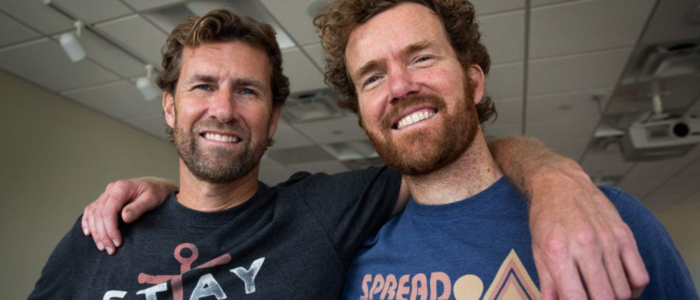Bottom Line Up Front: When the pandemic threatened to wipe away everything for this company, its founders pivoted, embracing direct-to-garment & e-commerce technology. They credit that move with helping them survive — and grow — through 2020. Read how they did it here.
When the pandemic hit Boston last year, the retail industry felt its impact. Fast.
Knowing that half of their business was oriented around wholesale orders, and that those wholesale customers were already closing up shop, brothers Bert and John Jacobs were forced to do some re-examining in order to avoid bankruptcy.
And that re-examining led them to a place of stability, growth, and community amid the chaos of 2020.
So how’d they do it? In this episode of Guy Raz’s How I Built This podcast, the Jacobs — both founders of the Boston-based apparel decorating company Life is Good — discuss their methods of adaptation that took them from serious crisis to reimagined growth in the nick of time. And they attribute most (if not all) of that transition to…
You guessed it. Having the right technology.
But before we get into the technological investments they made, let’s take a look at where Life is Good was before COVID-19 made its splash. Pre-pandemic, the company was earning $100 million in annual revenue. It had its Boston location, and it also had its distribution center — “the heart” of the company’s operations — in southern New Hampshire. Everything was going well. Business was booming.
But then the virus entered the picture. The vast majority of their wholesale customers were closing their doors, they didn’t have a clear path to sustaining their would-be profits, and they were looking right down the barrel of major lay-offs and bankruptcy.
So what saved them? Like their company name suggests, the Jacobs pride themselves on being rational optimists — taking the curveballs of life and never losing sight of their core mission: to spread gratitude, joy, and community.
Life is Good held onto that foundation. It just shifted its gears — in two major ways.
- Direct-to-Garment Printing
As the Jacobs say in the podcast, “inventory kills businesses” — and it’s true. Producing too much of a product that doesn’t sell or producing too little of a product that’s getting wiped off the shelves are common problems, and they can ruin a business’s profitability. Especially when there’s already uncertainty running rampant. With direct-to-garment printing (also known as print-on-demand), Life is Good didn’t have to commit.
And they didn’t have to bet everything on their commitments.
Instead, they only print once there’s an order. Sure, it’s more expensive to print per-unit, but it leaves them with perfect inventory, satisfied customers, and the freedom to actually listen to their audience.
- E-Commerce
Obviously, having the right buying framework in place is integral to making sure investing in production technology pays off. During the onset of the pandemic, that meant that Life is Good dedicated resources to making sure their e-commerce set-up was as high-functional and convenient as possible.
Because their business model shifted from wholesale customers to individual consumers, their focus shifted from satisfying the needs of major companies to satisfying the needs of individuals. Individuals who were being put through a scary, chaotic, and uncertain situation. So, they worked to ensure their buying experience was as simple, convenient, and enjoyable as it could be. And when direct-to-garment printing aligned with the right e-commerce set-up, there was an extremely expedited (and consumer-first) order fulfillment process that resulted — as well as no wasted inventory, and no operational delays.
With their open-to-adapting mindset, the Jacobs (and their whole Life is Good team) shifted their trajectory — and their earning potential. So far, they’ve managed to double their e-commerce revenue from 2019. The key, as they say in the podcast, has been listening closely to what their audience was telling them.
What were consumers looking for? What sort of messaging? What sort of products?
With direct-to-garment printing and e-commerce behind them, Life is Good was able to listen, understand, and implement on the fly. They weren’t limited by preordained inventory and they weren’t stuck within the confines of 2019 selling patterns. They could integrate COVID-relevant messaging on the products people had been flocking to since being stuck at home, and they could sell them in the ways that kept consumers safe, empowered, and satisfied.
The Jacobs hoped that investing in the right technology could swivel their year from doomed to booming — and that hope ended up paying dividends. A competitive advantage, tons of happy customers, and the knowledge that they’re helping their community get through a tough time together. It was a triple win.
If you’re curious to hear more details about the Jacobs’ adaptation process, we highly recommend giving the full podcast episode a listen.
The pandemic has forced most of us to do some substantial rethinking about our business models, our flexibility, and how we can best serve our customers’ needs today. Bert and John hit the nail on the head when they said that it “fast-forwarded” their path to progress, giving them no other option but to lean into the modern technology they’d been taking baby steps towards for years.
That technology has the power to turn things around — dramatically. Whether it’s direct-to-garmet printing equipment or the right e-commerce set-up (like Online Stores) or Online Designer, the digital tool that lets your consumers design their own products in real-time, investing in technology means investing in your business’s success.
No matter where life takes us next.


